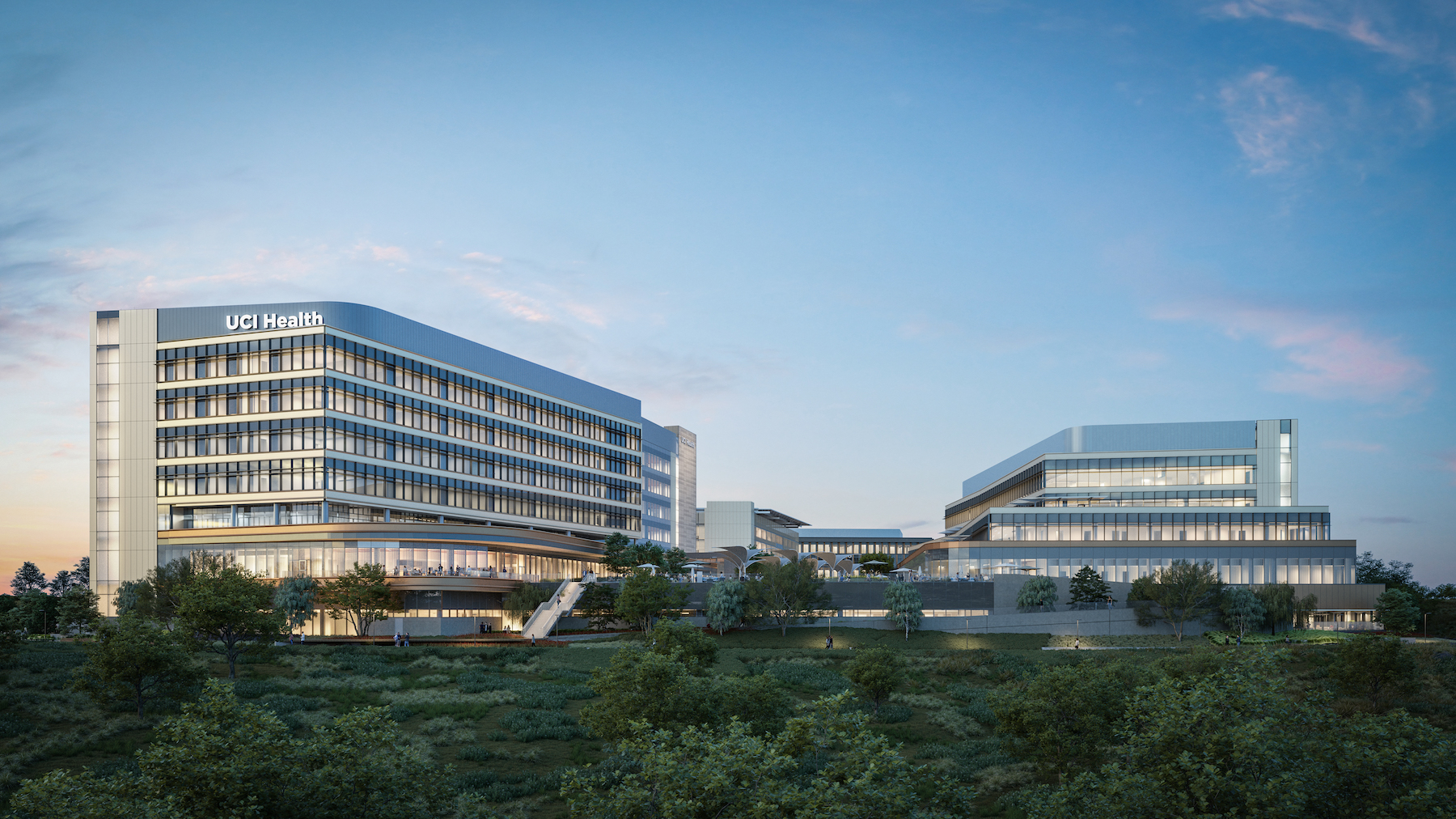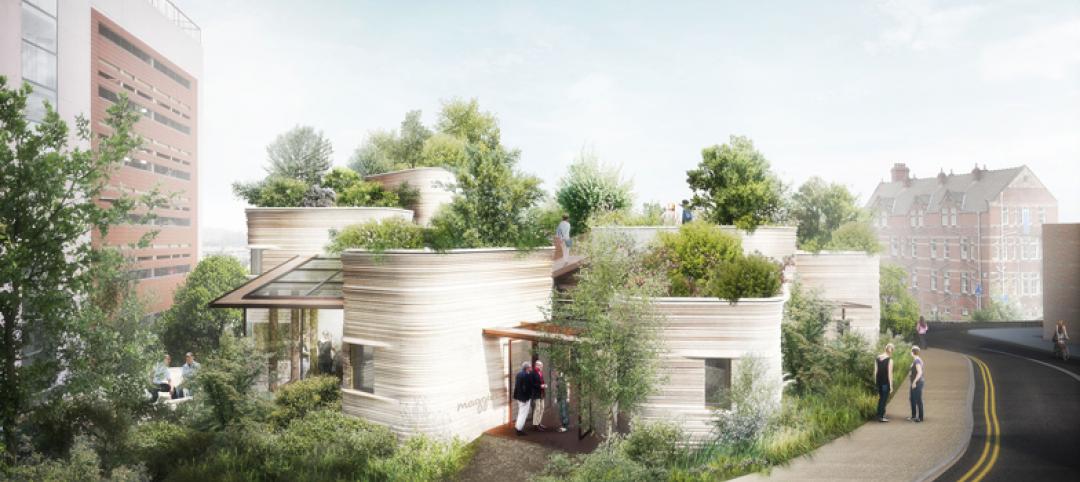The University of California at Irvine (UCI) has a track record for sustainability. It recently received LEED Platinum certification for its 23rd campus building. Its under-construction UCI Medical Center is designed, positioned, and built to preserve the nearby San Joaquin Marsh Reserve, to reduce the facility’s solar gain by 85%, and to be the first medical center in the country to operate on an all-electric central plant.
The University of California’s system favors sustainable solutions, including its requirement that new construction be all-electric. Instead of filing for a waiver, UCI determined that it could meet that requirement “at only a modest premium,” says Brian Pratt, UCI Campus Architect and Associate Vice Chancellor. (The premium would be around $2.5 million on a project whose construction cost is $770 million and all-in cost will be over $1 billion.)
UCI Medical Center will consist of a four-story, 357,000-sf hospital with 144 beds, operating rooms, 20 Emergency Department beds, and 16 acute observation beds; a 223,000-sf Comprehensive Cancer and Ambulatory Care Center with 36 exam rooms, outpatient surgery, labs, and a pharmacy; a 35,000-sf central plant; and a parking structure with 1,340 spaces.
The parking structure was completed last year, and the outpatient building and central plant are scheduled for completion next year. The hospital should be done in 2025. To meet California and national code requirements, the power system will be backed up by diesel fuel generators (see Editor's note below).

Electrification without compromise
The decision to go all-electric was made early in the design process, recalls Khristina Stone, Preconstruction Manager for the GC Hensel Phelps, which with CO Architects leads the Progressive Design-Build team on this project. Nick Spady, Hensel Phelps’ Operations Manager, says that installing the buildings’ electrical infrastructure and emergency generators pose the greatest challenges in an all-electric environment.
The bridging documents actually described an electric heating system that allowed for the use of natural gas for steam. But ultimately the design-build team and the university decided to dispense with steam boilers altogether, says Roger Carter, CEO and Senior Principal of tk1sc, the project’s MEP engineer.

Carter notes that state codes now require hospital rooms to have constant air volume, which can impact the heating system’s’ load. An all-electric system will allow UCI’s hospital to leverage the central plant’s heat-recovery chillers to manage the building’s energy performance. Indeed, going all-electric is not expected to compromise the medical center’s operations, whose universal design allows for all patient rooms to be converted to intensive care units.
UCI Medical Center is being built under a Progressive Design-Build contract, which Pratt says has been the university’s bid-out preference for decades. He notes that hospital projects are complicated with many stakeholders, and a Progressive Design-Build agreement “allows for expert feedback earlier in the project.”
He notes, parenthetically, that prior to construction UCI had worked with the architect HOK for a year on the medical center’s programming. “This put up guardrails on the project, but with enough room for flexibility.” Gina Chang, CO Architects’ Principal and Healthcare Team Lead, says there was also a program alignment period, during which the team could receive comment and suggestions from UCI and the hospital’s users.
“The bridging documents weren’t overly heavy, so the contract set up a more positive relationship [with UCI] for flexibility and creativity,” says Stone.
The rest of the Progressive Design-Build team includes Degenkolb (SE), Stantec (CE), Ridge Landscape Architects (LA), Newson Brown Acoustics (acoustical engineer), and Colin Gordon Associates (acoustical vibration).
Indoor and outdoor wellness

Aside from its electrification, UCI Medical Center features other sustainable elements. For example, the choice of brace framing, which Pratt says was “rooted in resilience,” reduces the project’s measurable embodied carbon by 20 percent. CO’s Chang further explains: “We implemented the lightest structural system possible (BRBF buckling restrained braced frame) to reduce the embodied carbon footprint. Though we sought for carbon reduction also with the concrete design, the site had high levels of methane and other greenhouse gasses that needed to be contained, so a larger, mat footing was utilized to mitigate that problem.”

After conducting several frit and shading studies, the design team optimized the building’s envelope to reduce its solar gain by 85 percent, and to minimize bird strikes.
The medical center will also tap into the city of Irvine’s robust recycled water infrastructure.
Chang says the marsh—which is managed by UCI biologists—drove the massing and position of the buildings. “We took seriously being a good neighbor to the marsh,” adds Pratt. The construction site includes a turtle fence. And the biologists said that runoff from the site was fine as long as it was treated.

Like most healthcare facilities, UCI Medical Center is placing a premium on wellness. It has multiple areas for gathering outdoors, including walkable pathways and so-called healing gardens that offer views of the landscaping. (The outside plaza between the hospital and outpatient buildings brushes up against the edge of the marsh.)
“The landscape design and plant palette matter,” says Pratt. “And the marsh in the differentiator.” Indoors are numerous terraces, and other places of respite that include “lavender” rooms where staff members under stress can retreat.
________
Editor's note: After this story was posted, Ray Swartz, an engineer and Senior Principal with tk1sc, the project's MEP engineer, responded to a reader's question about the Medical Center's backup power source in the event of an electrical outage:
Swartz said that California's Department of Health Care Access and Information enforces a minimum of 72 hours of fuel storage for a new NPC-5 building, not the 96 hours required by NFPA 110. However, NFPA 110 requires the main fuel tank(s) to have a minimum capacity of at least 133 percent of the quantity needed by CEC 700.12 (B) (2) Exception 1 or 2. Therefore, for NPC-5 buildings, the minimum capacity requirement is 133 percent of the 72-hour fuel supply, equating to 96 hours.
The UCI Medical Center project includes four 3,000-kW generators operating in parallel. The capacity is adequate to service the campus in a 100 percent business-as-usual format. The generators are diesel fuel type, and the campus has an underground fuel storage capacity of 65,000 gallons. If, in an emergency, refueling the tanks is feasible, the campus could operate continuously under generator power.
Related Stories
Healthcare Facilities | Jul 6, 2015
The main noisemakers in healthcare facilities: behavior and technology
Over the past few decades, numerous research studies have concluded that noise in hospitals can have a deleterious effect on patient care and recovery.
University Buildings | Jun 29, 2015
Ensuring today’s medical education facilities fit tomorrow’s healthcare
Through thought-leading design, medical schools have the unique opportunity to meet the needs of today’s medical students and more fully prepare them for their future healthcare careers. Perkins+Will’s Heidi Costello offers five key design factors to improve and influence medical education.
Sponsored | Healthcare Facilities | Jun 23, 2015
Texas eye surgery center captures attention in commercial neighborhood
The team wanted to build an eye surgery center in an already established area but provide something clean and fresh compared to neighboring buildings.
Healthcare Facilities | Jun 16, 2015
Heatherwick’s design for cancer center branch has ‘healing power’
The architect describes it as “a collection of stepped planter elements”
Healthcare Facilities | May 27, 2015
Roadmap for creating an effective sustainability program in healthcare environments
With a constant drive for operational efficiencies and reduction of costs under an outcome-based healthcare environment, there are increasing pressures to ensure that sustainability initiatives are not only cost effective, but socially and environmentally responsible. CBRE's Dyann Hamilton offers tips on establishing a strong program.
Healthcare Facilities | May 27, 2015
Rochester, Minn., looks to escape Twin Cities’ shadow with $6.5 billion biotech development
The 20-year plan would also be a boon to Mayo Clinic, this city’s best-known address.
Healthcare Facilities | Apr 28, 2015
10 things about Ebola from Eagleson Institute's infectious disease colloquium
Research institutions know how to handle life-threatening, highly contagious diseases like Ebola in the lab, but how do we handle them in healthcare settings?
Green | Apr 22, 2015
AIA Committee on the Environment recognizes Top 10 Green Projects
Seattle's Bullitt Center and the University Center at The New School are among AIA's top 10 green buildings for 2015.
Building Team Awards | Apr 10, 2015
14 projects that push AEC teaming to the limits
From Lean construction to tri-party IPD to advanced BIM/VDC coordination, these 14 Building Teams demonstrate the power of collaboration in delivering award-winning buildings. These are the 2015 Building Team Award winners.
Building Team Awards | Apr 10, 2015
Prefab saves the day for Denver hospital
Mortenson Construction and its partners completed the 831,000-sf, $623 million Saint Joseph Hospital well before the January 1, 2015, deadline, thanks largely to their extensive use of offsite prefabrication.

















